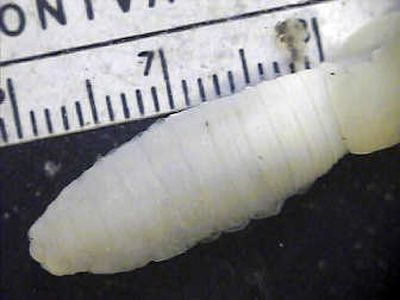Protection sought again for giant, spitting worms

Fans of the giant Palouse earthworm are once again seeking federal protection for the rare, sweet-smelling species that spits at predators.
They filed a petition Tuesday with the U.S. Fish and Wildlife Service requesting the worm be protected as an endangered species.
“The giant Palouse earthworm is critically endangered and needs the protection of the Endangered Species Act to have any chance of survival,” said Noah Greenwald of the Center for Biological Diversity.
The center filed the lawsuit along with Friends of the Clearwater, Palouse Prairie Foundation, Palouse Audubon and Palouse Group of Sierra Club.
The worm has been seen only four reported times in the past 110 years, but supporters contend it is still present in the Palouse, a region of about 2 million acres of rolling wheat fields near the Idaho-Washington border south of Spokane.
Decades of intense agriculture and urban sprawl have wiped out much of the worm’s habitat, said Steve Paulson with Friends of the Clearwater. Only about 2 percent of the Palouse prairie remains in a native state, he said.
The worm can reach 3 feet in length, is white in color and reportedly possesses a unique lily smell, said Greenwald, who is based in Portland, Ore. It is the largest and longest-lived earthworm in North America.
During the Bush administration, the agency rejected a similar petition from the groups, saying there was not enough scientific information about the species to prove it needed protection. The groups hope to have better luck with the Obama administration.
Officials for the Fish and Wildlife Service in Portland, Ore., did not immediately return telephone messages seeking comment.
In 1897, the giant Palouse earthworm was described as “very abundant” in the region, but sightings are rare. The last confirmed sighting was made on May 27, 2005, by a University of Idaho researcher. Before that, the worm had not been seen since 1988.
Most earthworms found in the Northwest originated in Europe, arriving on plants or in soil shipped to the New World. The giant Palouse earthworm is one of the few native species.
In previously rejecting endangered species protection, the Fish and Wildlife Service said there was too little information in the scientific record. That prevented the assessment of population trends.
The agency concluded that while the Palouse prairie has experienced a dramatic conversion of native habitat to agriculture, it was not clear if that hurt the worm. The agency also found no information on predation or transmission of pathogens by other earthworms to the giant Palouse earthworm.